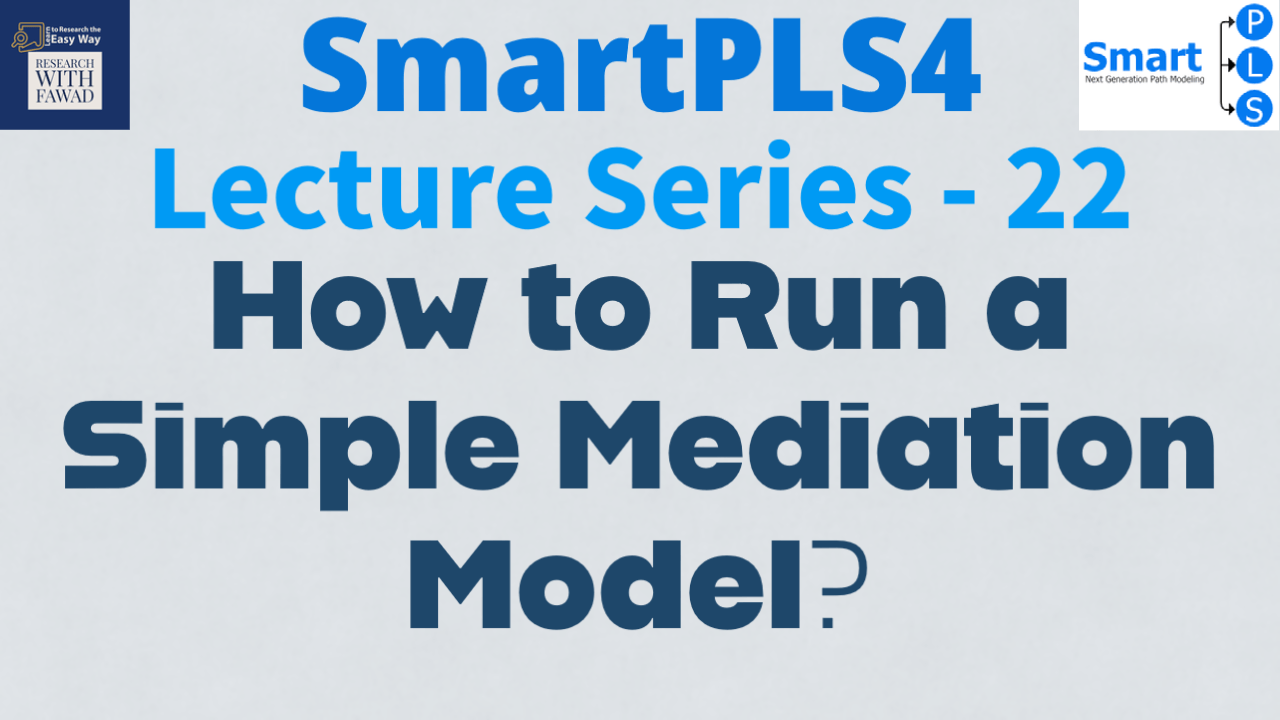Mediation Analysis using SmartPLS4
What is it All About?
The tutorial guides on how to run simple mediation analysis in SmartPLS4. The session will cover the concepts of mediation and afterwards mediation models are tested, interpreted, and reported.

Learn to Perform Mediation Analysis in SmartPLS4.
The tutorial is a step by step guide on how to perform Mediation Analysis using SmartPLS4
Do Like and Share the Video
What is Mediation?
- Mediation occurs when a construct, referred to as mediator construct, intervenes between two other related constructs.
- More precisely, a change in the exogenous construct causes a change in the mediator construct, which, in turn, results in a change in the endogenous construct in the PLS path model. When such an effect is present, mediation can be a useful statistical analysis, if supported by theory and carried out properly.
- Consider Fig. for an illustration of a mediating effect in terms of direct and indirect effects. A direct effect describes the relationships linking two constructs with a single arrow. Indirect effects are those structural model paths that involve a sequence of relationships with at least one intervening construct involved.
- Thus, an indirect effect is a sequence of two or more direct effects and is represented visually by multiple arrows. Figure shows both a direct effect p3 between Y1 and Y3 and an indirect effect of Y1 on Y3 in the form of a Y1 → Y2 → Y3 sequence.
- The indirect effect, computed as the product p1 ∙ p2, represents the mediating effect of the construct Y2 on the relationship between Y1 and Y3.
- Finally, the sum of the direct and indirect effect is referred to as the total effect (i.e., p1 ∙ p2 + p3 in Fig).
Systematic Mediation Analysis
Evaluation of the Mediation Model
- Evaluating a mediation model requires all quality criteria of the measurement and structural models to be met, as discussed in previous sessions. The analysis begins with the assessment of the reflective/formative measurement models.
- For example, a lack of reliability for one or more reflective mediator constructs will have a meaningful impact on the estimated relationships in the PLS path model (i.e., the indirect paths can become considerably smaller than expected).
- For this reason, it is important to ensure that the reflectively measured mediator constructs exhibit a high level of reliability.
- After establishing the reliability and validity of measurement models for the mediator as well as the other exogenous and the endogenous constructs, it is important to consider all structural model evaluation criteria.
High collinearity must not be present since it is likely to produce biased path coefficients. For example, as a result of collinearity, the direct effect may become nonsignificant, suggesting the absence of mediation even though, for example, complementary mediation may be present.
Likewise, high collinearity levels may result in unexpected sign changes, rendering any differentiation between different mediation types problematic.
Moreover, a lack of the mediator construct’s discriminant validity with the exogenous or endogenous construct might result in a strong and significant but substantially biased indirect effect, consequently leading to incorrect implications regarding the existence or type of mediation.
After meeting the relevant assessment criteria for reflective and formative measurement models, as well as the structural model, the actual mediation analysis follows.
Mediation Analysis Procedure
Reference
Hair Jr, J. F., Hult, G. T. M., Ringle, C. M., Sarstedt, M., Danks, N. P., & Ray, S. (2021). Partial least squares structural equation modeling (PLS-SEM) using R: A workbook.
Video Tutorials
Simple Mediation
Multiple Mediators
Reporting Mediation
Additional Resources
- A Basic and Simple Model in SmartPLS4
- Basic SEM Concepts – Convergent and Discriminant Validity
- Basic Structural Equation Modelling (SEM) Concepts
- Categorical Moderation Analysis using SEMinR
- How to Assess Construct Reliability?
- How to Assess Convergent Validity (Construct validity)
- How to Assess Discriminant Validity (Construct validity)
- How to Assess Reflective-Reflective Higher Order Construct
- How to Design a Measurement Model?
- How to Enter Data in SPSS or Excel
- How to Solve Discriminant Validity Issues
- How to Use Necessary Condition Analysis in SmartPLS4?
- Reflective-Formative Higher-Order Model using SmartPLS4
- Simple Structural Model in SmartPLS4
- SmartPLS4 Tutorials Series Introduction
- Steps in Data Analysis
- What is a Formative Construct?